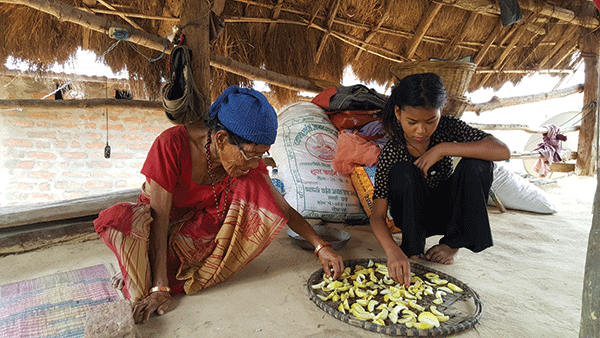The barrows and baskets are piled high with vegetables.There are green peppers that
seem to be recently plucked from the garden. There are egg-plants and aubergines that shine with their bold mauve shades. The cauliflowers radiate a rich white glow. The carrots and cucumbers give off whiffs of freshness and succulence, and the tomatoes stand firm and smooth, overwhelming the milieu with their rich red color.
Thus the whole setting dazzles the people with choices, for the delicacies to be prepared back home. For this is Kalimati Bazaar, the only organized wholesale marketplace for fruits, vegetables and fish in Kathmandu. Since 1987 it has been serving retailers, institutional consumers and the families residing in Kathmandu Valley, as a modern auction-based market. Initially, it started out as a group of open sheds selling vegetables in a squalid setting. But now with the help from UNCDF (United Nations Capital Development Fund), it is fully equipped with a building and a trained management team.
Standing more like a common terminal for the grocery produce from farms all over Nepal, vegetables and fruit are delivered here, freshly plucked from all parts of Nepal each day, from villages in and around Kathmandu Valley such as Dhading and Nagadesh and from as far afield as Kakarvitta in the Terai and sometimes even from India and China. The supplies coming from such a wide array of places definitely speak for the myriad options available. Besides, the offerings from places from so far and wide surely satiate our lingering tastes.
Seated comfortably amidst her stock of fresh vegetable supplies, Narayani Devi Duwal says she comes from the farming town of Nagadesh, lying in the north-eastern part of Bhaktapur. Speaking with a Newari twang, she admits that while members of her extended family grow the greens back in her village, she is responsible for marketing them. Arriving with her husband as early as 4 o’clock in the morning to her registered stall, she says that transactions begin as soon as the bazaar opens at 5am.
Sometimes, she says, it is difficult to follow the rush of her customers, who are mainly retailers; but she is quite satisfied with the sales she makes throughout the day. She is not the only one benefiting, however, for it is said that the marketplace creates links between more than two million interest groups consisting of farmers, wholesalers, retailers and consumers. About 400 traders are directly involved on their own account or as commission agents for farmers of different regions.
Unlike Narayani, who is working on a small scale, Bishnu Chatkhuli a member of the farmer’s cooperative in Dhading collects produce from all around his village of Dharke (on the road to Pokhara, below Naubise). For 5 years he has been selling the truckloads of produce he brings to Kalimati to the many stall-owners. He admits that a main purpose of the market is to maintain price uniformity.
So negotiation is done on par with the price set by the management team. This has made business for many farmers and agents like him easier, with no risks of being cheated with regards to price. He says the practice of off-season vegetable plantation has just started in Nepal, so it is more profitable to sell off-season produce, since they are limited in supply and obtain higher profits.
There is an agreement between all the stall-owners that most of their supplies such as potatoes, onions and even cabbages and cauliflowers get sold without any wastage, since they are not easily damaged. But others like tomatoes and aubergines spoil easily if not sold within a day or two. This is evident in the piles of waste collected at the backside of the market. Thus Narayani and many other stall owners like her reveal that a careful estimation of demand has to be made before bringing the produce to the market. But in spite of this, Kathmandu is often plagued by bandhs (for one petty reason or other), so that even careful speculation, sometimes, cannot prevent the loss and the wastage.
Kalimati Bazaar is not the only market catering the supplies of fruit and vegetables to the residents of Kathmandu. There are many satellite grocery markets of similar types, though smaller, in different neighborhoods of the city. Supermarkets and department stores are also equipped with their own vegetable stalls. Ultimately, however, their source is Kalimati Bazaar. Narayan Lamichane, a driver responsible for delivering supplies to various restaurants in the valley, loads sacks of potatoes in his white pick-up truck. Working for a contractor responsible for delivering supplies of vegetables and fisheries to many restaurants in town, he admits that all the contract agencies get their supplies from Kalimati Bazaar. It’s the same for the starred hotels, which also depend on contractors for their vegetable and fruit deliveries.
The residents of Kathmandu neighborhoods quite far-off from Kalimati bazaar enjoy the services provided by mobile-vegetable-vendors, commonly known as bhaiyas (given their Indian origin). They often travel to places as far as the other side of the valley such as Baneshwor and Koteshwor on their frail bicycles overloaded with fresh supplies from Kalimati.
The market area of Kalimati Bazaar is spread over 2.25 hectares of land, enough to accommodate a large number of people and vehicles; but, with all the institutional customers, restaurateurs and hoteliers from all over the valley overwhelming the marketplace, there’s always a struggle for space. The narrow passages bordered by sacks of onions and ginger are crammed with momentum and energy. People ignore a nudge here and an accidental push there, and there seems to be a kind of camaraderie between the clientele, with each understanding the other’s alacrity.
Vibrant with its dizzying colors and the cheerful vendors, the market literally explodes each morning into a celebration of sorts. The pace builds up as soon as the first of the white vans and the pickup trucks arrive, along with the mobile-vegetable-vendors at 5 o’clock, while local customers from nearby shops and houses start pouring in with their colorful shopping bags. A battle seems to start between neighboring stall-owners to lure customers their way. As one shouts of the freshness and smoothness of his tomatoes, another sings the praises of low priced cucumbers and radishes. Ultimately it’s not the flowery words and the million praises but the quality of the stock and the prices that bring one victory. Nonetheless, the verbal battles to top-off all continue throughout the day.
It is not only the noise and the commotion that get your attentions. The effervescent colors: red, yellow, green and orange, each juxtaposed side by side, reminds one of an artist’s palate. A walk through the market’s narrow labyrinthine passages is convincing enough to realize where ancient artists got the inspiration to extract the vibrant colors for their paintings. Besides, with the sellers and the buyers focused at one point, there seems to be bond created between them, a bond of understanding where one realizes the others plight. Consumers valuing their time gain momentum and rush about the bazaar in search of the items they require, while the traders develop their pace accordingly and often direct the consumers in their search. On the other hand, the buyers rarely tussle over the costs of the produce because they understand that this is the lowest one can offer.
By the end of the day, as the last of the rays of the sun shies away behind the hills, even with the help of blinking candles and lanterns the traders finish off with the last of their stocks to the gentle night crowd, shopping for supplies for the next day. Trying to avoid any wastage they, themselves, take the remaining few supplies back home. But before the melodrama has barely ended and, the rush and dizzying delights has merely subsided, in a few hours time (which feels more like minutes to these traders) the night turns into morning, too early, too soon. And the miasma of colors, commotion and energy begins all over again.
GOING ORGANIC
The bazaar is not limited to vegetables and fruit. If you aspire to tend a vegetable garden of your own or if gardening there is your hobby, Kalimati Bazaar is an appropriate destination to search for the high-quality hybrid seeds. All kinds of vegetable seeds, suited to growing in the valley’s clime are available here, especially in the alleyway at the west side of the main market space (outside of the market gate). Many of the seeds come from India, and if you are lucky some Japanese varieties are also available in limited amounts.
With the increasing interest in organic produce, what better option is there than maintaining your own organic kitchen garden. Appropriate natural fertilizers needed to maintain an organic garden are sold here, and the basic gardening tools that one can hardly do without are also available at these shops at good prices.
Some of the seeds available are: cauliflower (Rs 250), cabbage (Rs 200), chili (Rs 50), tomato (Rs 150), sweet pepper (Rs 300), cucumber (Rs 150), bitter gourd (Rs100), spinach (Rs 120), carrots (Rs 120) and pumpkin (Rs 120).
Mahesh Acharya, one of the shopkeepers of the seed bazaar says that until a few years ago his shop also sold seeds for flowers. But since, people usually associate the main bazaar with vegetables, there was no demand for flower seeds. Nowadays the only flower seeds for sale here are marigold, grown to decorate houses during the Tihar festival season.
The demand for the vegetable seeds depends upon the season. The climate of Kathmandu valley supports the cultivation of cauliflower, cabbage, spinach, carrots and radishes during the beginning months of winter (starting from mid-October to December), while the summer months favor the cultivation of pumpkins, okra, gourds and beans.










